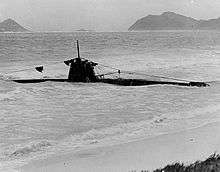Kazuo Sakamaki
| Kazuo Sakamaki | |
|---|---|
 | |
| Born |
November 8, 1918 Awa, Tokushima, Japan |
| Died | November 29, 1999 (aged 81) |
| Allegiance |
|
| Service/branch |
|
| Rank | Ensign |
| Battles/wars | Attack on Pearl Harbor |
Kazuo Sakamaki (酒巻和男 Sakamaki Kazuo, November 8, 1918 – November 29, 1999) was a Japanese naval officer who became the first Japanese prisoner of war of World War II captured by American forces.
Biography
Sakamaki was born in what is now part of the city of Awa, Tokushima Prefecture, one of eight sons. He was a graduate of the 68th class of the Imperial Japanese Naval Academy in 1940.
Attack on Pearl Harbor

Sakamaki was one of ten sailors (five officers and five petty officers) selected to attack Pearl Harbor in two-man Ko-hyoteki class midget submarines on 7 December 1941. Of the ten, nine were killed (including the other crewman in his submarine, Kiyoshi Inagaki). He had been chosen for the mission due to his large number of siblings. Sakamaki had set an explosive charge to destroy his disabled submarine, which had been trapped on Waimanalo Beach, Oahu. When the explosives failed to go off, he swam to the bottom of the submarine to investigate the cause of the failure and became unconscious due to a lack of oxygen. The book Attack on Pearl Harbor claims that his sub hit four coral reefs and sank. Sakamaki was found by a Hawaiian soldier, David Akui, and was taken into military custody. When he awoke, he found himself in a hospital under American armed guard. Sakamaki became the first Japanese prisoner of war in American captivity during World War II and was stricken from Japanese records and officially ceased to exist. His submarine was captured intact and was subsequently taken on tours across the United States as a means of encouraging the purchase of war bonds.[1][2]
After being taken to Sand Island, Sakamaki requested that he be allowed to commit suicide, which was denied. Sakamaki spent the rest of the war in prisoner-of-war camps on the mainland United States. At the war's end, he was repatriated to Japan, by which time he had become deeply committed to pacifism.[2]

Outside of writing a memoir, Sakamaki refused to speak about the war until 1991, when he attended a historical conference in Texas. He reportedly cried at the conference when he was reunited with his submarine for the first time in 50 years.[2]
After the war, Sakamaki worked with the Toyota Motor Corporation, becoming president of its Brazilian subsidiary in 1969. In 1983, he returned to Japan and worked for Toyota before retiring in 1987. He spent the rest of his life in Japan until his death in 1999 at the age of 81. He was survived by his wife and two children.[1]
Memoirs
Sakamaki wrote a memoir titled Four Years as a Prisoner-of-War, No. 1. He told of receiving mail from some Japanese denouncing him for not having committed suicide when it appeared he could be captured. His memoirs were translated and published in the United States on the eighth anniversary of the Pearl Harbor attack under the title I Attacked Pearl Harbor.[1]
Another Japanese World War II veteran, Sadaichi Fukui, said that though Sakamaki wrote his memoirs, he did not speak much about the war. Fukui said, "I think he had a lot of feelings he could not put in words about becoming the first prisoner of war at a time when falling into the hands of the enemy was the biggest shame."[1]
References
- 1 2 3 4 Kazuo Sakamaki, 81, Pacific P.O.W. No. 1 by Richard Goldstein, New York Times, December 21, 1999.
- 1 2 3 World War II's first Japanese prisoner shunned the spotlight by Burl Burlingame, Honolulu Star-Bulletin News, May 11, 2002.
Further reading
- Dorsey, James (1 July 2010). "Literary Tropes, Rhetorical Looping, and the Nine Gods of War: 'Fascist Proclivities' Made Real". In Alan Tansman. The Culture of Japanese Fascism. Duke University Press. pp. 409–431. ISBN 0-8223-9070-1. Retrieved 19 November 2016.
- Straus, Ulrich (1 October 2011). The Anguish of Surrender: Japanese POWs of World War II. University of Washington Press. pp. 8–16. ISBN 978-0-295-80255-8. Retrieved 19 November 2016. Sakamaki's experience as a prisoner of war are detailed in the first chapter "Prisoner Number One"